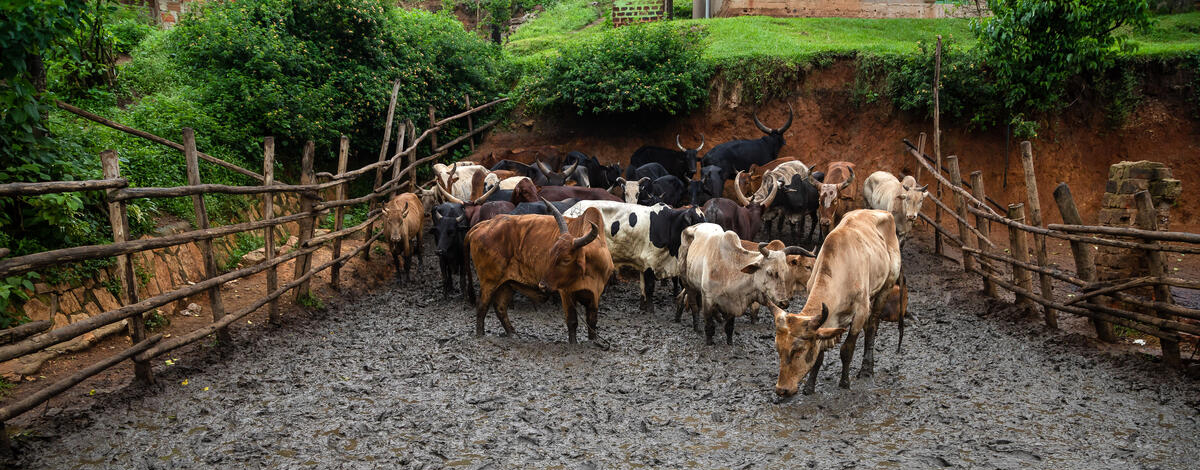Enhancing manure management for sustainable agriculture in Kenya and Uganda

Smallholder farms in sub-Saharan Africa often face nutrient limitations due to the high costs of synthetic fertilizers, leading to reduced crop productivity and income. Livestock manure presents a valuable resource to replenish soil nutrients and boost food security. However, improper manure management can result in nutrient losses, environmental degradation (such as greenhouse gas emissions and water pollution), and health risks, including disease transmission. An integrated One Health approach that considers biophysical, social, health, and economic dimensions to develop manure management interventions benefits animal, human, and ecosystem health.
The CIRcularity of Nutrients in Agroecosystems and Co-benefits on Animal and Human Health (CIRNA) project is a collaborative initiative aimed at developing and promoting effective manure management practices for smallholder farmers in Kenya and Uganda. By addressing environmental, health, and economic challenges, CIRNA seeks to enhance soil fertility, improve crop yields, and ensure the well-being of both humans and animals.
The overall objectives of the project are to:
- Develop and assess farmer-approved, field-tested manure management practices that enhance organic fertilizer quality, ensure safety for humans, animals, and the environment, and improve livelihoods.
- Inform policy by providing recommendations based on research findings to create an enabling environment for sustainable manure management practices.
FAO's role
FAO plays a pivotal role in the CIRNA project by leveraging its expertise in livestock environmental assessment and promoting the One Health approach. Employing its Global Livestock Environmental Assessment Model (GLEAM) to simulate the interactions within livestock production systems and their environmental impacts. GLEAM operates at various scales, global, regional, and national, to provide comprehensive analyses of greenhouse gas (GHG) emissions associated with livestock. In the context of CIRNA, FAO uses GLEAM to:
Quantify GHG emissions: Assess emissions from manure management practices in smallholder pig and dairy cattle systems in Kenya and Uganda.
Evaluate mitigation strategies: Analyze the potential impact of improved manure management interventions on reducing emissions and enhancing sustainability.
Inform policy development: Provide data-driven insights to guide policies aimed at promoting environmentally friendly and efficient livestock practices.
By integrating GLEAM's outputs, FAO helps identify practices that not only mitigate environmental impacts but also bolster food security and livelihoods.
Promoting the One Health approach
FAO advocates for the One Health approach, which recognizes the interconnected health of humans, animals, plants, and ecosystems. In the CIRNA project, this approach is operationalized by:
Enhancing animal health: Implementing better manure management reduces disease risks among livestock, leading to improved animal welfare and productivity.
Safeguarding human health: Proper handling and treatment of manure minimize exposure to pathogens and pollutants, thereby protecting farming communities.
Protecting environmental health: Sustainable manure practices prevent soil and water contamination, contributing to ecosystem integrity and resilience.
Through this holistic approach, FAO ensures that manure management interventions deliver co-benefits across multiple sectors, aligning with broader goals of sustainable development and public health.
The project aims to develop and promote farmer-approved manure management practices that enhance soil fertility, increase crop yields, and contribute to food security. By minimizing nutrient losses and greenhouse gas emissions, these practices also reduce environmental pollution. Proper manure handling mitigates health risks for both humans and animals, thereby improving overall well-being. Ultimately, the project seeks to strengthen the livelihoods of smallholder farmers through the adoption of sustainable agricultural practices.
Contact
Dominik Wisser
Phyllis Wanjugu Ndung’u
Find out more
- Global Livestock Environmental Assessment Model (GLEAM)
- ILRI website for more information on CIRNA's objectives, partners, and activities.
